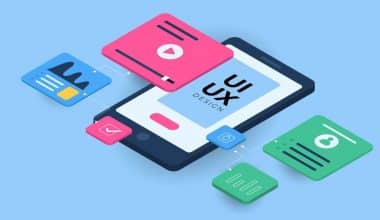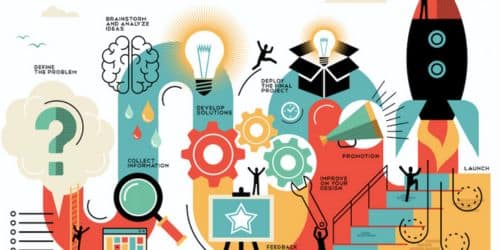Is becoming a UX designer anything that interests you? A job in product design could be ideal for you if you have an aesthetic sense and a desire to streamline inefficient items. The abbreviation “UX design” stands for “user experience design.” It covers the various methods by which consumers engage with a service or product. As a UX designer, you may make a significant impact on the product’s success by improving the user’s experience. Read on to know more about how to become a UX designer from scratch and without a degree. We also added the educational requirements and the courses you need to take to become a certified designer. Enjoy the ride!
What Is UX Design?
User experience design (UX design) is the process by which a company’s design team creates a product that delivers on the company’s brand promise while also satisfying the needs of its end users. User satisfaction can only be achieved via careful attention to every detail of the product’s design and functionality. A UI/UX designer’s duties include, among other things, investigating and analyzing user requirements.
An outstanding user experience (UX) is designed with the full lifecycle of the product in mind, from acquisition to maintenance. Generally speaking, the goal of user experience (UX) design is to provide a satisfying and productive journey for the consumer.
What Does a UX Designer Do?
A user experience designer, or UX designer, is part of a team that creates engaging content for a product’s target audience. Branding, usability, functionality, and developing a product’s aesthetics are just a few of the many responsibilities that come with the job. Although a UX designer may be responsible for some visual aspects of a product, this may vary greatly based on the company and the specifics of the project at hand. Common responsibilities of a UX designer include:
- Finding out what users care about through analyzing data
- Conducting interviews, questionnaires, and focus groups to gather information about a product
- creating personas that accurately represent a user’s traits and passions
- Developing representations, sketches, and working examples of a product.
Skills Required to Become a UX Designer
The following are the skills needed to become a UX designer:
#1. UX Research Skills
Researchers and analysts working on user experience initiatives need to be proficient in both qualitative and quantitative methods of data collection and analysis. Users are interviewed (either informally or formally), observed in the wild or in a lab setting, given surveys, and participate in focus groups.
#2. Ability to Wireframe and Prototype
A wireframe is a diagram that shows how a website page would look before any content is included. User interface and user experience (UI/UX) design decisions regarding which features to display and which to conceal, as well as where and how to display them graphically, are foundational to a positive user experience.
Images, call-to-action buttons, and menus are just some of the UI elements you’ll need to be able to diagram. After a concept or technique has been accepted in the form of wireframes, a mockup, or early version of the product, is created for testing purposes.
#3. Superior UX Writing Abilities
User experience (UX) writing requires a unique set of competencies. The microcopy, or text, of a digital product, is an integral part of its usability and user experience. Possessing solid UX writing skills can help you get there.
#4. Competence in Interaction Design
Digital devices designed for the general population must have intuitive interfaces. A product’s aesthetics, motion, sound, and the physical area in which it is used all play a role in how the product is actually used. User experience, ease of use, and the accessibility of information should all be top priorities.
#5. Capabilities in Visual Communication
User experience is about more than how a website looks and feels to visitors. Consider the playback button or the hamburger menu as examples of universal UI elements. Everybody who sees these icons knows exactly what they are and how to use them.
You can also read: USER EXPERIENCE DESIGNER: Definition, Duties, How to Become it, Salary & Certification
UX Designer Education Requirements
The following is the UX designer education requirements:
- Earn a Bachelor’s Degree (Optional, Four Years)
- Earn a Certificate in UX Design (Optional, Six to 12 Months)
- Gain Professional Experience (Timeline Varies)
- Earn a Master’s Degree (Optional, One to Two Years)
How to Become UX Designer
At least at the outset of their careers, most of the best UX Designers have learned their craft independently. How does one go about mastering the art of making their own visually appealing digital content? Learning UX design is like learning any other skill; there is no one best way to do it. The only way to reach where you want to go is to study and apply design theory and methodology. The following are the steps you need to take to become a UX designer:
#1. Learn the Basic Concepts of UX Design
Because the user experience (UX) of a website is so important to its overall success, understanding UX design principles is a must. With the user’s needs, wants, and personality in mind, UX designers craft interfaces to provide an optimal experience. Designing a digital product that satisfies the needs of the user and the business requires an in-depth knowledge of the reasons behind users’ actions, such as why they stay on a site or not.
#2. Create a Sense of Aesthetics
There is a limit to how much you can learn about design concepts simply by studying the basics. To hone your skills, examine critically the layouts of sites and apps you find appealing. The next time you go to a favorite website, pause for a while and consider what makes it so special to you. Is it the typeface, layout, or color scheme?
It is important to evaluate the site’s design in terms of the visual hierarchy, the spacing between elements, and the specific images and icons utilized. Figure out what does and does not work. This is crucial in order to have a good sense of design.
#3. Enroll in a Credible UX Course
It’s crucial to discover the right match while picking a UX design course. Selecting the appropriate course is crucial because it represents a considerable financial and time commitment toward your future success. The information below can be used to guide you in making a career-enhancing decision:
Learning via doing projects
Employers value applicants who can demonstrate expertise in both theory and practice. An excellent course gives students access to both specialized material and practical applications of that content.
Creates a portfolio
Employers often require a design portfolio as evidence of your abilities after completion of a course in this field. If you already have a portfolio and are looking to improve it, pick a course that will have you working on at least one project.
Human support
A live tutor is only one of the many perks of a hands-on UX designer course. Pick a class if it provides you with access to a tutor, mentor, or industry expert.
Specialized training
While it is usual for a UX course to recommend additional resources written by others, the best courses feature an expert authoring the bulk of the course material.
Career support
Find a user experience (UX) course that can help you land a job after you graduate. Some classes, for instance, incorporate a module specifically designed to help students get ready for the workforce.
#4. Create Practical UX Designs to Hone Your Skills
It’s important to put into practice as much of what you study when you decide to pursue a career as a UX designer. Doing as much design work as possible after finishing your degree will give you an edge. The following methods can be used to locate potential projects:
Offer your skills as a volunteer: Volunteering your skills is a terrific way to build your resume and help others at the same time. If you’re interested in volunteering, there are many options that may be found by searching online.
Make some changes: Unsolicited redesigns are great opportunities to put your skills to use and have some fun. A good place to begin is to think back on a UX that left a bad impression on you.
#5. Apply UX Design to Your Current Role
If you’re trying to study UX design while working full-time but don’t have much spare time, you can hunt for opportunities to practice in your current job. Find a problem that could arise and see if you can apply what you’ve learned about user experience design to it.
#6. Create a Portfolio of Your Work
If you’re just getting started with UX design, you can get some free starter kits to download and use. A user interface kit (UX kit) is a collection of reusable design elements created by a different designer. The inventor has made the kit available for free so that other UX designers can use it to enhance their own portfolios or as a resource for client projects. Making your own design mockups and sharing them online for comments is another option.
#7. Make Your Designs Known
There is an increasing number of people graduating from UX design programs with portfolios that look very similar. Because of this, it’s crucial to present designs that stand out from the crowd during the interview. It’s important to be able to explain what you’re working on, give a convincing presentation, and answer tough questions.
#8. Solicit Opinions From Your Clients
Getting constructive criticism could prove more useful than positive suggestions. It’s a fantastic method for honing your creative skills, expanding your toolkit, and coming up with innovative solutions. Actively seek out and embrace constructive criticism and utilize it to refine your designs. Post your work on Dribbble and ask the community there what they think of it.
In the long run, constructive criticism may be one of the best things to happen to your design career. Keep in mind that it’s not necessary to make radical changes to your skill set overnight. Achieving success requires consistent growth, and progressing by just one percent per day will do just that.
#9. Connect with Designers
Networking can open up a lot of doors for you in a creative field like UX design. You can gain inspiration and motivation by interacting with other designers. Many chances to work with and learn from others with greater expertise could present themselves to you as well. You don’t have to wait for a formal event to attend your first networking event. Beginning with a modest goal can be beneficial. You may learn about online networking sites to join and grow your contacts by doing some homework.
#10. Construct a Resume
Making a resume that stands out to hiring managers is a critical part of landing a user experience designer position. To get started, create your CV in the same way you would a user experience (UX) project. Keep in mind the people who might be reviewing resumes and write yours accordingly. Your resume may be seen by many non-technical people before it reaches a team with your level of UX design expertise. In order to advance your resume, these individuals may search for certain information or keywords.
#11. Submit Your Resume to Companies Hiring UX Designers
It’s time to start applying for UX designer jobs now that you have the necessary experience, degree, portfolio, and resume. Numerous opportunities for UX designers can be found on several job boards. Various UX design positions call for specialized knowledge in areas like content strategy, programming, or usability.
How to Become a UX Designer without a Degree
There are numerous paths to becoming a UX designer without a degree. Some people educate themselves independently by checking out books, documentaries, and online seminars. Some people seek out more experienced colleagues or mentors to help them get started.
The two most crucial steps are taking the first one and continuing to educate yourself. You will be well on your way to being a successful designer if you have a genuine interest in UX design. The following are ways to become a UX designer without a degree:
- Determine Your Ideal Career Path.
- Take a Free Course.
- Utilize Free Resources.
- Work on Projects.
- Complete a Bootcamp.
- Get a Certification.
- Gain UX Experience.
- Promote Your Skills
UX Designer Courses
The following are some of the UX designer courses you can go for:
#1. UX Design Course (General Assembly)
The User Experience Design Course provided by General Assembly can be taken at your own pace online. This course delves into the thought process behind UX design and equips students with the skills necessary to implement standard UX strategies. Students gain experience with digital design tools for creating wireframes, prototyping, and testing final products. Participants who finish the course will receive a signed completion certificate.
Those working in related industries, such as advertising, marketing, research, engineering, and others, will benefit most from this training. People in the middle of their careers who want to formalize their UX expertise, such as graphic designers, find this program appealing.
#2.User Experience: The Beginner’s Guide (Interaction Design Foundation)
The primary goal of this beginning course which spans seven weeks is to teach students the basics of user experience design. After completing the course, students should be able to describe the value of user experience design, use the terminology of UX design, and comprehend the duties and responsibilities of a UX designer. The goal of this course is to serve as a springboard into a broader curriculum.
If you want an introduction to the topic of interaction design but don’t yet know the fundamentals, this course is for you. It is also one of the best UX designer courses you can go for.
#3. Introduction to User Experience Design by Georgia Institute of Technology (Coursera)
Learners will get an overview of UX design as a methodical and data-driven approach in this six-hour online course. It provides a brief but comprehensive introduction to UX design by way of video lectures, texts, and quizzes, however, it lacks any real-world applications. Students who complete the course and pay for the completion certificate will have unlimited access to the course materials forever.
If you’re new to user experience design and want a crash course, this is the course for you. It’s perfect for people who want to learn about UX design but aren’t quite ready to start building practical abilities.
#4. User Experience (UX): The Ultimate Guide to Usability and UX (Udemy)
This introductory course teaches students how to apply UX thinking to their daily job. Through a series of five user research and design projects, students delve into prototyping, usability testing, user interviews, and other user-centered design techniques. Students will learn everything they need to know to pass the BCS Foundation Certificate in User Experience exam. At a pace of 60–90 minutes each day, students can finish the course in two to three weeks.
Also, it is one of the best UX designer courses you can go for. This course is designed for professionals working in sectors related to user experience who want to learn more about UX in order to better serve their clients.
#5. Intro to User Experience Design (SuperHi)
This primer provides the groundwork for further study in the field of user experience design. Each step of the user experience design process is covered in depth, from initial user research to wireframing and prototyping, user testing, and handoffs to stakeholders. Over five hours of video instruction and multiple assignments make up this comprehensive course.
Students should have some familiarity with common computer applications such as Word or Photoshop before enrolling in this course. This is the best option for traditional designers who are interested in creating digital products.
#6. Google UX Design Professional Certificate (Coursera)
This course, available on Coursera, guides students through every step of the process of creating a user interface. The goal of the course is to assist students to build a professional portfolio that includes three complete design projects that demonstrate their abilities in user experience design at the entry-level.
If you work on the course for 10 hours per week, you can finish it in around six months. A completion certificate is awarded to those who successfully complete the program. Participants should be confident in their ability to do design-related homework on their own, despite the course’s peer-to-peer feedback and discussion forums.
#7. UX & Web Design Master Course: Strategy, Design, Development (Udemy)
Students will learn the principles of user experience design and how to apply those designs using content management systems like WordPress. The course teaches students how to code websites using HTML, WordPress, and other technologies, with a focus on how business owners can use UX to enhance conversions. This low-cost alternative provides instruction in a wide range of marketable abilities.
It is also one of the best UX designer courses you can go for. Anyone interested in learning the basics of user experience design, including company owners looking to improve their online visibility, web designers looking to broaden their toolkit, and traditional artists interested in making the transition to digital media, are encouraged to enroll in this course.
What Qualifications Do I Need to Be a UX Designer?
A UX designer should ideally have a background in graphic design, interface design, human-computer interaction, or a similar subject. They may also have a bachelor’s degree in engineering, business, or another field and be certified in user experience design.
What Are the Requirements to Become a UX Designer?
Qualifications for a UX designer include knowledge of front-end technologies, user-centered design, mobile-first design, and responsive layout, as well as experience with UX design, UX software, prototyping, user research, and testing, teamwork, and communication.
How Long Does It Take To Become a UX Designer?
Becoming a UX designer might take as little as three months or as long as six years. The time it takes to become a UX designer might vary greatly because there are no set regulations requiring a specific degree, certification, or licensing.
How Do I Become a UX Designer With No Experience?
- Determine Your Ideal Career Path.
- Take a Free Course.
- Utilize Free Resources.
- Work on Projects.
- Complete a Bootcamp.
- Get a Certification.
- Gain UX Experience.
- Promote Your Skills
Is It Hard to Get Hired as a UX Designer?
There are a number of reasons why finding employment in UX is challenging. First of all, the job market is competitive for designers. That’s why businesses have to work so hard to stay ahead of the competition. They can choose a highly experienced candidate, even though that’s not a requirement for the position.
Does UX Require Coding?
Undoubtedly, a UX designer should learn how to code. An understanding of programming is helpful, but not necessary, for a UX Designer to effectively interact with the rest of the development team.
Final Thoughts
Building an online portfolio of your best work and the design process you used is essential to get hired for UX design positions.
Get the ball rolling on your hunt for entry-level UX design jobs right now. The job search is a great way to practice important soft skills like communicating and explaining the reasoning behind your ideas, so don’t worry if you don’t get hired straight away. These skills are widely sought by hiring managers in prospective designers.
Related Articles
- UX DESIGN INTERNSHIP: 20 Best User Experience Design Intern Jobs 2023
- UX ENGINEER: Duties, Salary, and How to Become One
- User Experience Research: Meaning, Method, Certificate, and How to Become One,
- USER EXPERIENCE DESIGNER: Definition, Duties, How to Become it, Salary & Certification
- WHAT IS WEB DESIGNER: What They Do and Salary






